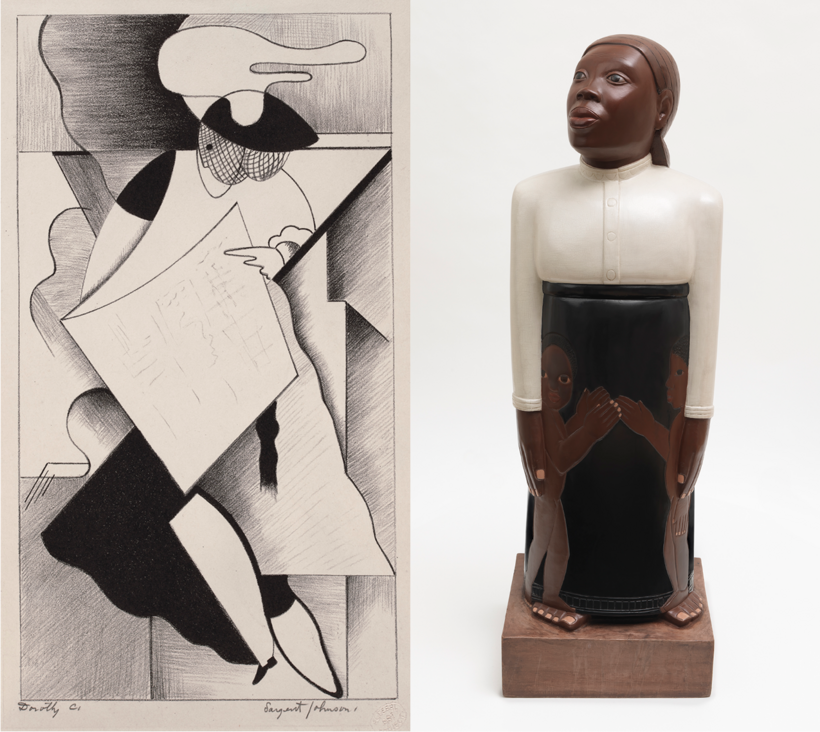When was it born—Sargent Claude Johnson’s acute sensitivity to the portrayal of Black Americans? It may have been when he learned that an uncle had narrowly avoided being lynched for a perceived threat to a white woman. Or when his white father and Black mother had to flee the Jim Crow South. Or when two of his siblings decided to pass permanently as white. Or when he had to work as a dining-car waiter to make his way West to the Bay Area, where he was eventually recognized as one of the foremost artists of the Black Renaissance.
Johnson’s youthful experiences of the racial divide in America tugged at him. “At its heart,” we learn from the curators and scholars who worked on the retrospective “Sargent Claude Johnson,” opening today at the Huntington Art Museum, “his oeuvre was devoted to giving voice to the lives of Black people.” The multifaceted output of this pioneering artist included sculpture, graphic art, painting, murals, and ceramics. He was also a beloved teacher. “In the long arc of brilliant African American cultural production in the twentieth century,” continue the organizers, “the art of Sargent Claude Johnson stands out.”

Johnson was born in Boston, in 1888, and had lost both parents by the time he was 14. Despite being passed among family members and eventually dispatched to an orphanage, Johnson completed high school and studied music. Yet when he arrived in San Francisco just in time to see the international splendors of the Panama-Pacific International Exposition of 1915, he opted instead for art school, where his attraction to diverse cultures was nurtured.
In the 1920s, it was the multicultural group of children in his Berkeley neighborhood who first captured his imagination and set his sculpture on a prizewinning course. Formed in wood and porcelain, whether glazed or polychromed, his figures evoked ancient traditions, particularly those of Asia, and helped him avoid being marginalized.

Gradually, after absorbing African and Egyptian influences, he became an advocate for a more authentic racial physiognomy—certainly a novel notion in the 1930s. “It is the pure American Negro I am concerned with, aiming to show the natural beauty and dignity,” he said. “I wish to show that beauty not so much to the white man as to the Negro himself.” In works such as Forever Free (1933), an eloquent wood sculpture of a mother and two children, he exaggerated Black characteristics. During his many Mexican sojourns, he took note of the Indigenous folk traditions in works by Diego Rivera, José Clemente Orozco, and David Alfaro Siqueiros.
Johnson’s work was recognized by the Harmon Foundation with a series of exhibitions that made him one of the few Black artists to have a national career. By the 1940s, however, he was swept up by the prevailing winds of abstraction and pivoted from the racial typing for which he had become known. Monumental Bay Area commissions followed, including the George Washington High School Athletics mural (185 feet long), in the Richmond District, and the San Francisco Aquatic Park, where the Federal Arts Project of the Works Progress Administration artists joined together to decorate the Streamline Moderne–style Aquatic Park Bathhouse building, today home to the San Francisco Maritime Museum. Johnson carved the grand entrance frieze—a depiction of the waterfront that included hidden references to its gay denizens—and the vibrant green-and-white, Cubist mosaic murals that face the bay.

The Huntington’s own Johnson jewel, its first major acquisition by an African-American artist, purchased in 2011, is three sections of a boldly carved, Art Deco, gilded-redwood organ screen completed in 1934 for the music hall of the California School for the Blind, then located in Berkeley. It is exhibited here in its entirety for the first time. The saga of how the museum, renowned for its collection of historic portraits of royalty, came to acquire a section of the screen—which in 1980 was stored and forgotten in a U.C. Berkeley warehouse, was mistakenly sold in 2009 for a measly $164.63, and then passed through the hands of two dealers before the Huntington swooped in with a big figure—is testament to the institution’s increased commitment to a collection that represents America’s diversity.
Alas, by the 1960s, Johnson himself had been forgotten. Despite his mastery, his commissions waned, and he worked in a frame shop. He died in a small hotel room in 1967.
“Sargent Claude Johnson” is on display at the Huntington Art Museum, in San Marino, California, until May 20
Patricia Zohn has contributed to numerous publications, including Wallpaper, Artnet, the Huffington Post, The New York Times, and the Los Angeles Times


